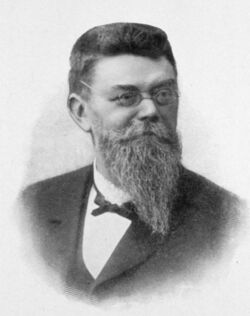Biography:Joseph Grasset
Joseph Grasset (18 March 1849 – 7 July 1918), was a French neurologist and parapsychological investigator, born in Montpellier.[1]
He received his medical degree (1873) in Montpellier, where in 1881 he became a professor of therapy. In 1886, he attained the chair of clinical medicine, and in 1909 was appointed chair of general pathology.[1]
Grasset was involved in every aspect of internal medicine, but his primary interest concerned diseases of the nervous system. His name is associated with the "Grasset law", 'a condition where a patient with hemiparesis lying on his back can raise either leg separately, but is unable to raise both legs together.'[2]:649 This phenomenon is explained in his 1899 treatise, Diagnostic des maladies de la moëlle.[1]
He conducted studies in the field of psychiatry, publishing the book Demi-fous et Demi-responsables (Semi-Insane and the Semi-Responsible) in 1907, and also researched the paranormal, publishing works with titles such as Le spiritisme devant la science (1904) and L’occultisme hier et aujourd'hui (1907).[1]
His book L’occultisme hier et aujourd'hui was translated into English as The Marvels Beyond Science in 1910. Grasset took a psychological approach to psychical research and attributed mediumship to deliberate trickery or unconscious suggestion.[3][4]
Selected publications
- The Diagnosis of Diseases of the Cord (1901)
- The Semi-Insane and the Semi-Responsible (1907)
- The Marvels Beyond Science (1910)
References
- ↑ 1.0 1.1 1.2 1.3 Biography of Joseph Grassett ("Who named it?").
- ↑ Clarac, François; Boller, François (2009-01-01), Aminoff, Michael J.; Boller, François; Swaab, Dick F., eds., "Chapter 40 History of neurology in France" (in en), Handbook of Clinical Neurology, History of Neurology (Elsevier) 95: pp. 629–656, http://www.sciencedirect.com/science/article/pii/S0072975208021404, retrieved 2020-06-03
- ↑ "Review: Science And The Occult Reviewed Work: The Marvels Beyond Science by Joseph Grasset". The British Medical Journal 2 (2712): 1714. 1912.
- ↑ Bock, Martin (2007). "The Power of Suggestion: Conrad, Professor Grasset, and French Medical Occultism". Conradiana 39 (2): 97–112. doi:10.1353/cnd.2007.0013.


